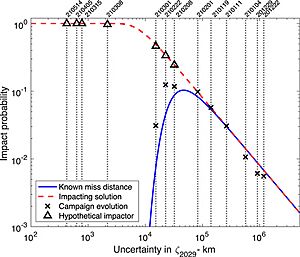Palermo scale facts for kids
The Palermo scale is a special tool astronomers use to measure how dangerous a near-Earth object (NEO), like an asteroid or comet, might be to our planet. It helps them rate the potential risk of an impact.
The scale looks at two main things: the chance of an object hitting Earth and how much energy the impact would release. It combines these two pieces of data into a single number.
- A rating of 0 means the object's risk is the same as the normal "background hazard." This is the average risk from other space objects of the same size that could hit Earth over many years.
- A rating of +2 means the danger is 100 times greater than the usual background risk.
- A rating between −2 and 0 means the object is interesting and needs to be watched closely.
- A rating below −2 means the object is very unlikely to cause any trouble.
There is another, simpler scale called the Torino scale, which is often used to explain the risk to the public.
As of mid-2025, no known asteroid has a rating above 0. Only two asteroids have a rating between −2 and 0, meaning they are being monitored, but are not considered a major threat. In the past, a few asteroids had higher scores, but as scientists studied them more, their risk levels were lowered.
Contents
How the Palermo Scale Works
The Palermo scale was created for scientists to have a detailed, technical way to compare impact risks. It was officially adopted in 2001 at a meeting in Palermo, Italy, which is how the scale got its name.
The main idea is to compare a specific threat to the normal, everyday risk. Scientists call this normal risk the "background risk." It's the average chance of an object of a certain size hitting Earth over a long period.
If a newly discovered asteroid has a Palermo scale value of -2, it means it is only 1% (or 1/100th) as dangerous as a random background event. A value of 0 means it's just as dangerous as the background risk. A value of +1 means it is 10 times more dangerous.
When an asteroid has several possible impact dates, scientists can calculate a "cumulative" Palermo scale rating. This combines the risks from all the potential impact dates into one overall score.
How Scientists Calculate the Risk
Space agencies like NASA and the ESA have special teams that track NEOs. At NASA's Jet Propulsion Laboratory (JPL), the Center for Near-Earth Object Studies (CNEOS) calculates these risks and keeps a list called the Sentry Risk Table.
To figure out the risk, scientists use all the observations they have of an asteroid to calculate its orbit. However, because measurements are never perfectly exact, there's always a small amount of uncertainty about the asteroid's exact path. This creates an "uncertainty region," which is an area in space where the asteroid will most likely pass by Earth.
When an asteroid is first discovered, this uncertainty region is very large. As scientists make more observations, they get a better idea of the asteroid's orbit, and the uncertainty region shrinks.
Interestingly, this can sometimes cause an asteroid's risk score to go up at first. This is because as the uncertainty region gets smaller, it might look more likely to cross paths with Earth. But with even more observations, scientists can usually confirm that the asteroid will miss Earth completely, and the risk score then drops to zero.
Asteroids with High Ratings
Over the years, a few asteroids have received high Palermo scale ratings, causing scientists to watch them very carefully.
- In 2002, an asteroid named (89959) 2002 NT7 briefly had a positive rating of 0.18. This meant it was considered a higher-than-average threat. However, after more measurements, it was found to be safe and was removed from the risk list.
- For a short time in December 2004, the asteroid [[99942 Apophis{{{2}}}|99942 Apophis{{{2}}}]] held the record for the highest Palermo scale rating ever: 1.10. This suggested that an impact in 2029 was almost 12.6 times more likely than a random background event. After years of tracking, scientists confirmed it would safely miss Earth, and Apophis was removed from the risk list in 2021.
- The asteroid (29075) 1950 DA once had a high rating for a possible impact in the year 2880. Its rating has gone up and down as new data has become available. As of mid-2025, it is one of the most closely watched asteroids.
As of mid-2025, the two asteroids with the highest cumulative Palermo scale ratings are (29075) 1950 DA and 101955 Bennu. Both have ratings below 0, meaning they are less of a threat than the average background risk, but they are still monitored.
| Asteroid | Peak Hazard | Hazard as of 10 April 2025[update] | ||||
|---|---|---|---|---|---|---|
| Palermo rating | Risk relative to background risk |
Torino rating | Palermo rating | Risk relative to background risk |
Torino rating | |
| 99942 Apophis | 1.10 | 12.6× greater (1260%) | 4 | removed from list on 21 February 2021 | ||
| (89959) 2002 NT7 | 0.18 | 1.51× greater (151%) | 1 | removed from list on 1 August 2002 | ||
| (29075) 1950 DA | 0.17 | 1.48× greater (148%) | - | −0.92 | 8.32× less (12.0%) | - |
| background risk | 0 | equal (100%) | - | 0 | equal (100%) | - |
| 2024 YR4 | −0.18 | 1.51× less (66.1%) | 3 | −4.25 | 17,783× less (0.0056%) | 0 |
| (144898) 2004 VD17 | −0.25 | 1.78× less (56.2%) | 2 | removed from list on 14 February 2008 | ||
| (410777) 2009 FD | −0.44 | 2.75× less (36.3%) | - | removed from list on 19 November 2020 | ||
| 2022 AE1 | −0.66 | 4.57× less (21.9%) | 1 | removed from list on 20 January 2022 | ||
| 2023 GQ2 | −0.70 | 5.01× less (20.0%) | 1 | removed from list on 1 May 2023 | ||
| 2013 TV135 | −0.73 | 5.37× less (18.6%) | 1 | removed from list on 8 November 2013 | ||
| (367789) 2011 AG5 | −1.00 | 10× less (10%) | 1 | removed from list on 21 December 2012 | ||
See also
 In Spanish: Escala de Palermo para niños
In Spanish: Escala de Palermo para niños
- Asteroid impact avoidance
- Asteroid impact prediction
- Earth-grazing fireball
- Impact event
- List of asteroid close approaches to Earth
- List of Earth-crossing asteroids
- Time-domain astronomy



